How Sherry is Produced
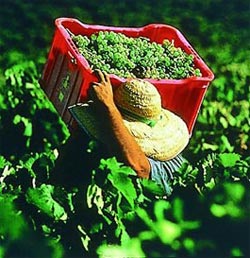 In the month of September the green stalk connecting each bunch of grapes to the vine darkens and the grapes themselves "surrender", turning soft and sweet. There is no exact date for beginning the harvesting, because it depends on the maturity of the grapes which must be at least 10.5º baume. The harvest lasts approximately twenty days, usually from the end of August to mid-September.
In the month of September the green stalk connecting each bunch of grapes to the vine darkens and the grapes themselves "surrender", turning soft and sweet. There is no exact date for beginning the harvesting, because it depends on the maturity of the grapes which must be at least 10.5º baume. The harvest lasts approximately twenty days, usually from the end of August to mid-September.
The "cutting" of the bunches is usually carried out manually so that the grapes arrive at the 'lagar' or winepress in optimal conditions. To this end, plastic boxes with a capacity no greater than 18kg. (40 lb) are used. When full, they are then stacked in order to ensure that the fruit is not damaged during its trip from the fields to the winepress.
Grapes to produce dry wines are quickly transported to the wine-making plants. On the other hand, those to be made into sweet wines, especially Pedro Ximenez and Muscat grapes, are set out in the open air on esparto grass mats to raise their sugar content while lowering their moisture content by evaporation. During this process, the grapes are covered at night to protect them against the dew. The length of time of this operation continues depends upon climatic conditions and may last more than one week.
The Pressing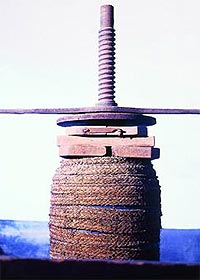 Once in the winery, the grapes are unloaded onto conveyor belts where stems, leaves, and unsuitable bunches are discarded in order to reduce tannin. The suitable grapes then pass into machines that crush them gently to open up the berries skins. The grapes then pass directly to the presses where, through the light application of pressure, the "mosto de yema" (first must) is obtained. This process yields 70 Iitres of must per I00 kg of grapes. Only the must from this first pressing will be used to produce Sherry Wines.
Once in the winery, the grapes are unloaded onto conveyor belts where stems, leaves, and unsuitable bunches are discarded in order to reduce tannin. The suitable grapes then pass into machines that crush them gently to open up the berries skins. The grapes then pass directly to the presses where, through the light application of pressure, the "mosto de yema" (first must) is obtained. This process yields 70 Iitres of must per I00 kg of grapes. Only the must from this first pressing will be used to produce Sherry Wines.
The wine houses usually carry out further, more energetic, pressings to extract the remaining liquid from the grapes. The juice from these medium and higher-pressure extractions can never be used in the production of Sherry although it can be used, under the watchful eye of the Regulatory Council, to produce other wines which are not classified as Sherry, as well as for distillation or for obtaining other sub-products.
The Palomino Grape gives must that is low in acidity, typically at a pH range of 3.5-3.7, but it can be as high as 4.0. Correction of acidity is commonly used to bring the pH to ~3.2 (or 4.5 g/l before fermentation. Traditionally this was done by addition of Yeso (plaster or gypsum). This is basically calcium sulfate, which reacts with potassium hydrogen tartrate in the must to generate (soluble) potassium sulfate, precipitating calcium tartrate and releasing tartaric acid. Tartaric acid is usually used directly when acidification is needed. Of course, the main need to increase acidity was due to the picking of very ripe grapes, and with better means now available to assess maturity, it is possible to pick grapes before they lose acidity.
Fermentation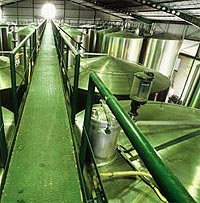 The "mosto de yema" (first must) obtained from the pressing goes directly into vertical stainless steel tanks to be fermented, a temperature-controlled process which takes place at between 22°C and 24ºC. Fermentation used to be performed by natural yeasts, but growers are now adding cultivated yeasts. There is an increasing tendency to include flor yeasts in the yeast preparation used to seed fermentation. This improves the chances for getting development of a good flor cover immediately after fermentation. Temperature-controlled fermentation also makes it possible to select a lower temperature in order to direct the path toward Fino production, or a slightly (3°) higher temperature to favour Oloroso production. The temperatures in either case are higher than would be usual for a white table wine. The basic idea here is not to produce a fruit-driven wine, but to make a base wine with good extract and low acidity that can mature in the solera system.
The "mosto de yema" (first must) obtained from the pressing goes directly into vertical stainless steel tanks to be fermented, a temperature-controlled process which takes place at between 22°C and 24ºC. Fermentation used to be performed by natural yeasts, but growers are now adding cultivated yeasts. There is an increasing tendency to include flor yeasts in the yeast preparation used to seed fermentation. This improves the chances for getting development of a good flor cover immediately after fermentation. Temperature-controlled fermentation also makes it possible to select a lower temperature in order to direct the path toward Fino production, or a slightly (3°) higher temperature to favour Oloroso production. The temperatures in either case are higher than would be usual for a white table wine. The basic idea here is not to produce a fruit-driven wine, but to make a base wine with good extract and low acidity that can mature in the solera system.
Some Houses still practice the old system of fermenting in new oak barrels or "botas", with the dual purpose of preparing the casks for later use in the long Sherry ageing process and at the same time achieving a characteristic vinification of the must. The fermentation process in the Jerez Region is divided into two clearly differentiated stages. In the first days the so-called "stormy" or "tumultuous" fermentation process takes place during which 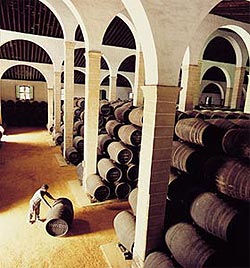 more than 90 per cent of the total sugar contained in the grape is converted into ethyl alcohol and carbon dioxide.
more than 90 per cent of the total sugar contained in the grape is converted into ethyl alcohol and carbon dioxide.
After this first phase, there is a second, slow stage, lasting until the beginning of December after which a delicate, totally dry white wine with an alcohol content of between 11 and 12% vol. is obtained, whose characteristic will determine its classification before entering the ageing process. In this classification the taster's sense of smell and taste are essential guides; this is the decisive moment at which a new wine's suitability for a particular Sherry type is determined. The first classification of Sherry Wines takes place before the must is racked off lees (sediment deposited during fermentation). The first cold days of Winter help to precipitate all of the solid particles to the bottom of the vats and the wine becomes clean and transparent, with an alcohol content of between 11 to 12% vol.
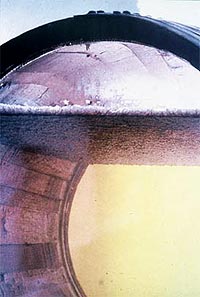 The Mystery of the "Flor"
The Mystery of the "Flor"
Wine tasters now sample all of the individual butts and take the first of many important decisions which will determine the type of ageing which that year's different wines will undergo. Some of the palest, lightest wines that are clean to the nose with outstanding aroma will be set aside for ageing "bajo flor", under a veil of "flor", in order to produce FINO and MANZANILLA styles of Sherry. Other wines, also clean on the nose and palate, but with more body will be classified as OLOROSOS. The wines classified as Finos or Manzanillas will be fortified with wine-distillate (pure alcohol (96%), added over a period of hours so as not to have an abrupt effect) to bring their alcohol content up to 15% vol. while those destined to become Olorosos will be fortified to 17% or slightly higher, according to each houses' individual style.
These different levels of fortification and alcohol content will determine the type of development undergone by the wines in the next phase of their ageing. The wines, with their new alcohol content, are transferred to typical oak barrels called butts, or "botas" for the first stage of their ageing known as "sobretablas". Different to other wine regions were the wines age in hermetically sealed vessels in order to prevent their oxidation, the ageing process for Sherry and Manzanilla takes place in 600 litre American oak butts which are filled to 5/6 of their capacity, leaving a volume of air inside the butt "two fists high".
The next development of Sherry is determined by whether flor (meaning flower) forms on the surface of the wine. The thicker the layer of Flor, [as pictured right in a special cut-away barrel] the drier and finer the style of Sherry.
In the case of Finos and Manzanillas - at 15º - the veil of "flor" remains constant an all of the wine's free surface inside the butt. This flor 'veil' is formed by live yeasts belonging to the genus Saccharomyces ellipsoideus, (in particular S. beticus, S. cheresiensis and S. rouxii) The Beticus is usually the strongest (it is encouraged by heat and predominates, especially in Jerez). These yeasts have the unusual property of living in alcohol levels above 15%. The flor forms as soon as fermentation is completed and the wine is racked off the lees. The flor grows on alcohol, glycerol, and 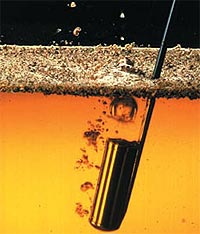 other nutrients provided by the wine. The proaerobic; because it requires oxygen, the flor yeasts live at the surface where they form a protective cap that prevents oxidation of the wine.
other nutrients provided by the wine. The proaerobic; because it requires oxygen, the flor yeasts live at the surface where they form a protective cap that prevents oxidation of the wine.
During this time, the yeasts are interacting constantly with the wine, consuming its alcohol and other nutrients and endowing it with its characteristic aromas and flavours. This type of ageing process is known as "crianza biologica" or biological ageing.
Yeast in the flor layer are continually dying (the dead cells fall to the bottom of the cask) and being replaced by new growth. (The butts in a Fino Solera have to be cleaned out every 25 years or so because of the accumulation.) Sometimes, in the case of Fino or Manzanilla wines which are aged biologically, the veil of "flor" might reduce or even disappear. This might be due to natural causes or according to a decision taken by the head cellarman who fortifies them above the yeasts' maximum limit. If flor dies off in casks of a Fino that are more than 3 years old, this gives rise to the class of Sherry Wines known as AMONTILLADO, a jewel among the world's wines. If the flor dies sooner, the wine can only be used for a blended style (such as Medium) and cannot be used for Fino or Amontillado. In the case of Olorosos, fortified to over 17% vol., this higher strength impedes the development of the "flor" and this growth disappears. The wine is therefore in permanent and direct contact with the oxygen in the air. This ageing is known as oxidative or physical-chemical ageing.
 The Ageing of Sherry: the "Crianza"
The Ageing of Sherry: the "Crianza"
In the ageing cellars the wines repose organised according to their different degrees of ageing. The butts, or "botas" are lined up in rows on three or four different levels, each of which corresponds to a scale. The lowest row or scale is known as "solera" (from the Spanish word suelo, or ground)* and contains the oldest wine. The butts in the row immediately above it, the primera criadera, or first nursery, contain wine somewhat younger than the row beneath and in the row above that, the second nursery, the wines are younger still. And so on until we reach the last and highest row.
Wine for bottling is always drawn off from the ground-level butts ("solera") by an operation known as the saca. Only a small amount of wine is taken from each butt during the saca. Later, the wine extracted from the butts on the ground-level row is replaced by the same quantity of wine from the first nursery. This wine in turn is replaced with wine from the second nursery and so on up to the wines on the highest row of butts, which are finally blended with the new wines from the last harvest. This operation is known in Jerez as "running the scales" and is usually carried out with implements called the "canoe" and the "sprinkler" [pictured below] so that the new wine drips into the butt little by little, as if it were dew, so that the "flor" protecting the wine will not be damaged. The ageing system of Sherry Wines is therefore a dynamic process and involves a methodical blending of the young wines with other, more mature wines in order for them to acquire gradually the fine qualities of old wines which have enjoyed many years of ageing.
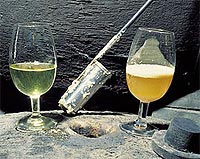 Although in exceptional cases some Sherry houses age their wines statically by a system of anadas, or vintages, the criaderas y solera method is indisputably the genuine ageing process for Sherry. The blending of wines originating from many different vintages means that it is impossible to refer to a specific year's harvest - sherry with a vintage added to the label must be a misnomer. But a sherry labelled Solera (say) 1990 purports to show that it comes from a group of butts laid down that year, and theoretically, there always remains an infinitesimal fraction of the original wine. It is possible to establish an average age for the solera or ground-level wine based on a series of factors such as the number of scales or criaderas, the percentage of wine transferred every time the scales are run, or the frequency of the operation itself.
Although in exceptional cases some Sherry houses age their wines statically by a system of anadas, or vintages, the criaderas y solera method is indisputably the genuine ageing process for Sherry. The blending of wines originating from many different vintages means that it is impossible to refer to a specific year's harvest - sherry with a vintage added to the label must be a misnomer. But a sherry labelled Solera (say) 1990 purports to show that it comes from a group of butts laid down that year, and theoretically, there always remains an infinitesimal fraction of the original wine. It is possible to establish an average age for the solera or ground-level wine based on a series of factors such as the number of scales or criaderas, the percentage of wine transferred every time the scales are run, or the frequency of the operation itself.
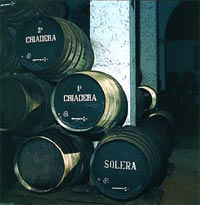 The minimum ageing for a Sherry Wine is three years although it is frequently much longer. Specific types of wine only acquire their most genuine characteristics after decades of ageing. For this reason, the Denomination of Origin Regulatory Council allows certain Sherry Wines which are particularly old to include on their labels their average age. However, to obtain this privilege the bodega involved has to undergo a series of highly specific tests.
The minimum ageing for a Sherry Wine is three years although it is frequently much longer. Specific types of wine only acquire their most genuine characteristics after decades of ageing. For this reason, the Denomination of Origin Regulatory Council allows certain Sherry Wines which are particularly old to include on their labels their average age. However, to obtain this privilege the bodega involved has to undergo a series of highly specific tests.
When Sherry is finally bottled, the wine is clarified and filtered, put through cold stabilization, filtered, and bottled under inert gas. Sulphur dioxide is not used, except at the start of fermentation.
*- no one quite knows how the word Solera came to stand for this complicated Jerez system of equalising wines. One of the meanings of the word is a "plinth" and this might give some clue to the provenance of the word, for it has been argued that when the bodegas were formerly used as drinking rendezvous for the friends of the proprietor, guests used to ask for their next glass off the floor, i.e. from the lower butts on the scantling which were the best.
